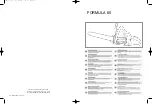
Check for parts online at
www.getearthquake.com
or call 800-345-6007 M-F 8-5
17
Operator's Manual
CS3814, CS3816, CS4116 Chainsaws
Bar and chain oil
The saw is equipped with an adjustable chain oiler. The oil
pump, driven by the drive sprocket, will only pump oil when the
engine is running at high enough speeds to engage the clutch
and rotate the chain. Furthermore, the flow of oil is adjustable to
accommodate variations in chain oil due to temperature.
To adjust the oil pump, insert a screwdriver in the small notch
beneath the clutch and drive sprocket. To increase the flow
of oil, turn the screwdriver counter-clockwise. To decrease
the flow of oil, turn the screwdriver clockwise. For optimum
performance, use a higher rate of flow with thicker oil or in
colder temperatures, and a lower rate of flow with thinner oil or
in warmer temperatures.
The guide bar and saw chain need to be well lubricated during
operation to prevent permanent damage from friction and heat.
Be sure to check the oil supply to the bar and chain before use.
1. After starting the engine, hold the saw up with the chain
suspended in front of or above a test surface.
2. Run the engine at about half throttle.
3. Oil should be flung off of the rotating chain onto the test
surface.
If the saw chain seems dry, but there is some oil present on the
bar or test surface, the oil pump may be set too low. Increase
the setting by turning the adjustment screw counter-clockwise.
If the saw chain and guide bar are dry and there is no oil on the
test surface, the oiler port and guide bar may need cleaning.
Remove the clutch cover, bar, and chain, and clean under the
clutch cover with a brush and clean the guide bar with a wire or
small screwdriver.
Reassemble and retest for oil presence. If no oil is present after
adjusting the oiler setting and cleaning the oiler port, the oil
pump may not be functioning. Discontinue use of the unit and
contact your local authorized service center or customer service
for assistance.
In compliance with EPA regulations, any adjustments to the
carburetor must be made by an authorized service center.
An authorized service center is capable of troubleshooting
carburetor problems, adjusting carburetors to perform correctly,
and adjusting carburetors to compensate for altitude.
IMPORTANT NOTE: Carburetor is set at factory. Further
adjustment must be performed by an authorized service center.
Contact customer service for a list of authorized service centers.
engine maintenance
cooling fins
Cooling fins, air inlets, and linkages must be free from any debris
before each use.
air filter
Never run engine without air cleaner properly installed. Added wear
and engine failure may occur if air cleaner is not installed on engine.
Service air cleaner every 3 months or after 20 hours of operation.
Clean filter daily in extremely dusty conditions.
steps for cleaning air filter
1. Remove the air cleaner cover by turning the thumb screw on top
of the power unit counter-clockwise and lifting the cover off.
2. To remove the filter, lift the filter element off of the threaded stud.
3. Larger surface dust and dirt particles can be removed from the filter
element by lightly tapping a corner of the filter against a hard surface.
4. To clean finer dust trapped in the mesh screens, split the filter
by inserting a flat screwdriver between the dogs on one corner
of the filter element and twisting.
5. Using an air compressor at a low pressure or a store-bought
compressed air duster, blow air through the mesh from the inside.
6. Press the two filter halves back together by squeezing around the
rim. Do not place pressure on the mesh or a puncture could occur.
7. Place the filter back over the threaded rod, making sure to seat
the filter on the O-ring on the carburetor.
8. Place the air cleaner cover back on the saw body and turn the
thumb screw clockwise until finger tight.
spark plug
The recommended spark plug is a NGK BPM6A, Champion CJ7Y,
or Torch L7TC.
steps for removing the spark plug
1. Remove the air cleaner cover by turning the thumb screw on top
of the power unit counter-clockwise and lifting the cover off.
2. Disconnect the spark plug cap and clean any debris from
around the spark plug area.
3. Remove spark plug using the “Scwrench” multi-tool. Replace if
any of the following occur; pitted electrodes, burned electrodes,
cracked porcelain, or deposits around the electrodes.
4. After analysis, seat spark plug and turn by hand until finger
tight.








































